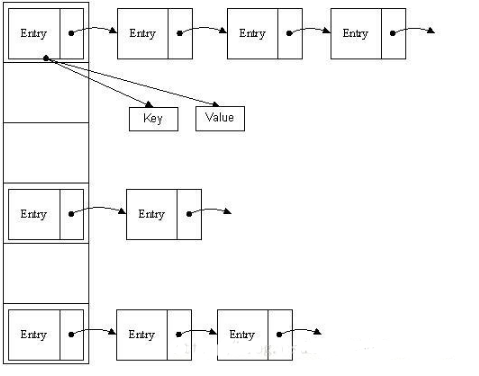更新時(shí)間:2021-07-12 16:33:18 來源:動(dòng)力節(jié)點(diǎn) 瀏覽809次
數(shù)據(jù)結(jié)構(gòu)中有數(shù)組和鏈表來實(shí)現(xiàn)對數(shù)據(jù)的存儲(chǔ),但這兩者基本上是兩個(gè)極端。
數(shù)組
數(shù)組存儲(chǔ)區(qū)間是連續(xù)的,占用內(nèi)存嚴(yán)重,故空間復(fù)雜的很大。但數(shù)組的二分查找時(shí)間復(fù)雜度小,為O(1);數(shù)組的特點(diǎn)是:尋址容易,插入和刪除困難;
鏈表
鏈表存儲(chǔ)區(qū)間離散,占用內(nèi)存比較寬松,故空間復(fù)雜度很小,但時(shí)間復(fù)雜度很大,達(dá)O(N)。鏈表的特點(diǎn)是:尋址困難,插入和刪除容易。
哈希表
那么我們能不能綜合兩者的特性,做出一種尋址容易,插入刪除也容易的數(shù)據(jù)結(jié)構(gòu)?答案是肯定的,這就是我們要提起的哈希表。哈希表((Hash table)既滿足了數(shù)據(jù)的查找方便,同時(shí)不占用太多的內(nèi)容空間,使用也十分方便。
哈希表有多種不同的實(shí)現(xiàn)方法,我接下來解釋的是最常用的一種方法——拉鏈法,我們可以理解為“鏈表的數(shù)組”,如圖:


從上圖我們可以發(fā)現(xiàn)哈希表是由數(shù)組+鏈表組成的,一個(gè)長度為16的數(shù)組中,每個(gè)元素存儲(chǔ)的是一個(gè)鏈表的頭結(jié)點(diǎn)。那么這些元素是按照什么樣的規(guī)則存儲(chǔ)到數(shù)組中呢。一般情況是通過hash(key)%len獲得,也就是元素的key的哈希值對數(shù)組長度取模得到。比如上述哈希表中,12%16=12,28%16=12,108%16=12,140%16=12。所以12、28、108以及140都存儲(chǔ)在數(shù)組下標(biāo)為12的位置。
HashMap其實(shí)也是一個(gè)線性的數(shù)組實(shí)現(xiàn)的,所以可以理解為其存儲(chǔ)數(shù)據(jù)的容器就是一個(gè)線性數(shù)組。這可能讓我們很不解,一個(gè)線性的數(shù)組怎么實(shí)現(xiàn)按鍵值對來存取數(shù)據(jù)呢?這里HashMap有做一些處理。
首先HashMap里面實(shí)現(xiàn)一個(gè)靜態(tài)內(nèi)部類Entry,其重要的屬性有key,value,next,從屬性key,value我們就能很明顯的看出來Entry就是HashMap鍵值對實(shí)現(xiàn)的一個(gè)基礎(chǔ)bean,我們上面說到HashMap的基礎(chǔ)就是一個(gè)線性數(shù)組,這個(gè)數(shù)組就是Entry[],Map里面的內(nèi)容都保存在Entry[]里面。
/**
* The table, resized as necessary. Length MUST Always be a power of two.
*/
transient Entry[] table;
既然是線性數(shù)組,為什么能隨機(jī)存取?這里HashMap用了一個(gè)小算法,大致是這樣實(shí)現(xiàn):
// 存儲(chǔ)時(shí):
int hash = key.hashCode(); // 這個(gè)hashCode方法這里不詳述,只要理解每個(gè)key的hash是一個(gè)固定的int值
int index = hash % Entry[].length;
Entry[index] = value;
// 取值時(shí):
int hash = key.hashCode();
int index = hash % Entry[].length;
return Entry[index];
(1)put
疑問:如果兩個(gè)key通過hash%Entry[].length得到的index相同,會(huì)不會(huì)有覆蓋的危險(xiǎn)?
這里HashMap里面用到鏈?zhǔn)?a href="/hot/1624.html" target="_blank" title="數(shù)據(jù)結(jié)構(gòu)">數(shù)據(jù)結(jié)構(gòu)的一個(gè)概念。上面我們提到過Entry類里面有一個(gè)next屬性,作用是指向下一個(gè)Entry。打個(gè)比方,第一個(gè)鍵值對A進(jìn)來,通過計(jì)算其key的hash得到的index=0,記做:Entry[0]=A。一會(huì)后又進(jìn)來一個(gè)鍵值對B,通過計(jì)算其index也等于0,現(xiàn)在怎么辦?HashMap會(huì)這樣做:B.next=A,Entry[0]=B,如果又進(jìn)來C,index也等于0,那么C.next=B,Entry[0]=C;這樣我們發(fā)現(xiàn)index=0的地方其實(shí)存取了A,B,C三個(gè)鍵值對,他們通過next這個(gè)屬性鏈接在一起。所以疑問不用擔(dān)心。也就是說數(shù)組中存儲(chǔ)的是最后插入的元素。到這里為止,HashMap的大致實(shí)現(xiàn),我們應(yīng)該已經(jīng)清楚了。
public V put(K key, V value) {
if (key == null)
return putForNullKey(value); //null總是放在數(shù)組的第一個(gè)鏈表中
int hash = hash(key.hashCode());
int i = indexFor(hash, table.length);
//遍歷鏈表
for (Entry<K,V> e = table[i]; e != null; e = e.next) {
Object k;
//如果key在鏈表中已存在,則替換為新value
if (e.hash == hash && ((k = e.key) == key || key.equals(k))) {
V oldValue = e.value;
e.value = value;
e.recordAccess(this);
return oldValue;
}
}
modCount++;
addEntry(hash, key, value, i);
return null;
}
void addEntry(int hash, K key, V value, int bucketIndex) {
Entry<K,V> e = table[bucketIndex];
table[bucketIndex] = new Entry<K,V>(hash, key, value, e); //參數(shù)e, 是Entry.next
//如果size超過threshold,則擴(kuò)充table大小。再散列
if (size++ >= threshold)
resize(2 * table.length);
}
當(dāng)然HashMap里面也包含一些優(yōu)化方面的實(shí)現(xiàn),這里也說一下。比如:Entry[]的長度一定后,隨著map里面數(shù)據(jù)的越來越長,這樣同一個(gè)index的鏈就會(huì)很長,會(huì)不會(huì)影響性能?HashMap里面設(shè)置一個(gè)因子,隨著map的size越來越大,Entry[]會(huì)以一定的規(guī)則加長長度。
(2)get
public V get(Object key) {
if (key == null)
return getForNullKey();
int hash = hash(key.hashCode());
//先定位到數(shù)組元素,再遍歷該元素處的鏈表
for (Entry<K,V> e = table[indexFor(hash, table.length)];
e != null;
e = e.next) {
Object k;
if (e.hash == hash && ((k = e.key) == key || key.equals(k)))
return e.value;
}
return null;
}
(3)null key的存取
null key總是存放在Entry[]數(shù)組的第一個(gè)元素。
private V putForNullKey(V value) {
for (Entry<K,V> e = table[0]; e != null; e = e.next) {
if (e.key == null) {
V oldValue = e.value;
e.value = value;
e.recordAccess(this);
return oldValue;
}
}
modCount++;
addEntry(0, null, value, 0);
return null;
}
private V getForNullKey() {
for (Entry<K,V> e = table[0]; e != null; e = e.next) {
if (e.key == null)
return e.value;
}
return null;
}
(4)確定數(shù)組index:hashcode%table.length取模
HashMap存取時(shí),都需要計(jì)算當(dāng)前key應(yīng)該對應(yīng)Entry[]數(shù)組哪個(gè)元素,即計(jì)算數(shù)組下標(biāo);算法如下:
/**
* Returns index for hash code h.
*/
static int indexFor(int h, int length) {
return h & (length-1);
}
按位取并,作用上相當(dāng)于取模mod或者取余%。
這意味著數(shù)組下標(biāo)相同,并不表示hashCode相同。
(5)table初始大小
public HashMap(int initialCapacity, float loadFactor) {
.....
// Find a power of 2 >= initialCapacity
int capacity = 1;
while (capacity < initialCapacity)
capacity <<= 1;
this.loadFactor = loadFactor;
threshold = (int)(capacity * loadFactor);
table = new Entry[capacity];
init();
}
注意table初始大小并不是構(gòu)造函數(shù)中的initialCapacity!!
而是 >= initialCapacity的2的n次冪!!!!
Java中hashmap的解決辦法就是采用的鏈地址法。
當(dāng)哈希表的容量超過默認(rèn)容量時(shí),必須調(diào)整table的大小。當(dāng)容量已經(jīng)達(dá)到最大可能值時(shí),那么該方法就將容量調(diào)整到Integer.MAX_VALUE返回,這時(shí),需要?jiǎng)?chuàng)建一張新表,將原表的映射到新表中。
/**
* Rehashes the contents of this map into a new array with a
* larger capacity. This method is called automatically when the
* number of keys in this map reaches its threshold.
*
* If current capacity is MAXIMUM_CAPACITY, this method does not
* resize the map, but sets threshold to Integer.MAX_VALUE.
* This has the effect of preventing future calls.
*
* @param newCapacity the new capacity, MUST be a power of two;
* must be greater than current capacity unless current
* capacity is MAXIMUM_CAPACITY (in which case value
* is irrelevant).
*/
void resize(int newCapacity) {
Entry[] oldTable = table;
int oldCapacity = oldTable.length;
if (oldCapacity == MAXIMUM_CAPACITY) {
threshold = Integer.MAX_VALUE;
return;
}
Entry[] newTable = new Entry[newCapacity];
transfer(newTable);
table = newTable;
threshold = (int)(newCapacity * loadFactor);
}
/**
* Transfers all entries from current table to newTable.
*/
void transfer(Entry[] newTable) {
Entry[] src = table;
int newCapacity = newTable.length;
for (int j = 0; j < src.length; j++) {
Entry<K,V> e = src[j];
if (e != null) {
src[j] = null;
do {
Entry<K,V> next = e.next;
//重新計(jì)算index
int i = indexFor(e.hash, newCapacity);
e.next = newTable[i];
newTable[i] = e;
e = next;
} while (e != null);
}
}
}
以上就是動(dòng)力節(jié)點(diǎn)小編介紹的"HashMap實(shí)現(xiàn)原理",希望對大家有幫助,想了解更多可查看Java基礎(chǔ)教程,如有疑問,請?jiān)诰€咨詢,有專業(yè)老師隨時(shí)為您服務(wù)。

初級 202925

初級 203221

初級 202629

初級 203743